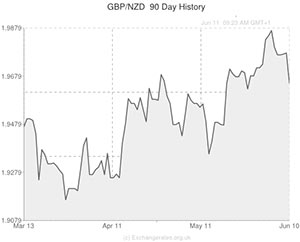
The Pound to New Zealand Dollar exchange rate plunged to a fresh 3-week low late last night in reaction to the Reserve Bank of New Zealand’s decision to hike the overnight cash rate from 3.00% to 3.25%.
GBP/NZD declined by over a cent from 1.9620 to 1.9510 as RBNZ Governor Graeme Wheeler intimated that the bank intends to continue with its hiking cycle despite the recent drop-off in dairy prices. Prior to the central bank announcement traders had reduced their Q2 2015 rate projections by 15 basis points due to the reduced outlook for dairy exports.
The high-beta ‘Kiwi’ Dollar also benefitted from a general mood of positive risk sentiment among investors. With economic developments boding well for global growth over the past week – the ECB unleashed a string of stimulus measures last Thursday, the latest US non-farm payroll report printed strongly on Friday and Japanese GDP smashed expectations on Sunday evening – traders have been piling into the New Zealand Dollar to take advantage of its relatively high yield value.
Earlier on in the day GBP/NZD fluctuated slightly in reaction to the latest UK labour market figures. The headline unemployment rate slid by more-than-expected from 6.8% to a fresh 5-year low of 6.6%, as the British economy added a further 345,000 jobs in the period of February to April. The rapid rise in job creation means that there are currently more people in the workforce than ever before; the 30.45 million figure is the highest since the Office for National Statistics (ONS) starting keeping records in 1971.
Sterling initially rallied by 0.4 cents in reaction to the robust employment gain figures.
However, the Pound’s strength proved fleeting as traders digested the implications of a less optimistic section of the report: the average weekly wages figure. The ONS reported that, compared to expectations of 1.2%, wage growth decelerated from 1.7% to 0.7% in the three-month period leading up to April.
With inflation currently running much higher than wage growth – at 1.8% – investors lost their bullish appetite for the UK currency. It is believed that the Bank of England will not look to start raising interest rates ahead of schedule, even if the jobless rate continues to tumble, as long as real wages remain in the red. This is because the improvements in the labour market are unlikely to have an upward impact on the consumer price index without the advent of rising real wages.
The drop in real wages was particularly worrying given that the current period of negative wage growth is the third worst in the last 150 years. It was worse in the 1860s and also during the Great Depression of the 1920s.
Another factor emerging from the labour market report that weighed on demand for Sterling was the total number of hours worked figure. The ONS reported that employees worked 1.5% more hours during the period surveyed but disappointingly Gross Domestic Product only improved by 1.1% during that same period, signaling that the productivity gap widened between February and April. This hurt the Pound because the BoE has stated that it will not raise interest rates until there are signs that the slack in the labour market has been erased.

Comments are closed.